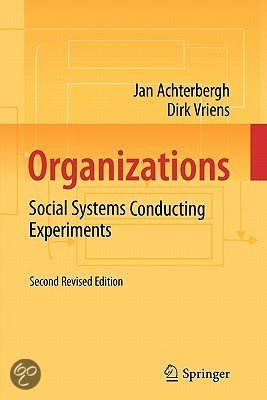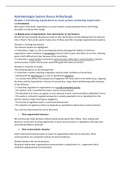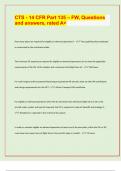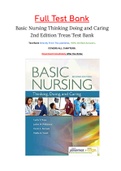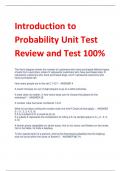Aantekeningen System theory Achterbergh
Chapter 1: Introducing organisations as social systems conducting experiments
1.1 Introduction
Main topic of this book: organizations as social systems conducting experiments and finding
principles to improve their design.
1.2 Making sense of organizations: from ‘phenomena’ to ‘key features’
We will use two everyday situations to point at their key features and by relating these key features
into a ‘theory’ that can be used to make sense of these and other everyday organizational situations.
Situation 1: Strategy formulation
Two relevant aspects are highlighted:
1. It describes a stage in a more encompassing activity (strategy formulation) in which an
organization under conditions of uncertainty commits itself to goals that affect its survival. Selecting
goals is both difficult and risky: because of the uncertainty.
2. It describes a social activity consisting of communication referring to communication: previous
communication is taken into account aswell (like goals that were set earlier).
Situation 2: A worker in trouble
The following aspects can be distinguished:
1. It describes a worker selecting a regulatory activity under conditions of uncertainty
- Dealing with the disturbances is a case of operational regulation
- It is unclear what effects the selected act of regulation will have, both for the worker (e.g., angering
the boss) and the organization’s chances of survival (e.g., angry clients withdrawing orders because
of late delivery)
2. It describes regulation in organizations as a socially embedded activity
- The workers ‘task’ is specified by means of prior communication
- The disturbance he faces can appear as such, because of prior communicatively established ‘norms’
- The worker is inclined to regulate because he is socially expected to do so. Deviating from this
activity may be socially construed as negligence.
- The activity of regulation itself is a communicative process
- The selection of regulatory actions co-depends on expectations about future communications
Thus, two key features/arches can be discerned:
1. Their experimental character
We continuously make decisions without being certain about their effects. Thus, making such
decisions can be seen as doing experiments in which every decision is a hypothesis. We hope that
some desired effect is achieved.
2. Their social systemic character
Social interaction/communication is central to organizations and more in particular, these
communications are connected. (system of communications)
Relation between the two key features
Reciprocal relationship: organizational communication is about/refers to… experiment which
conditions organizational communication.
,1.3 Organizations as social systems conducting experiments
Here we combine the earlier mentioned features.
• Conducting experiments
First of all we state that the stake in these experiments is meaningful survival. Survival = that an
organization maintains a separate existence in its environment (abstract/poor) + maintaining a
separate and meaningful existence in its environment (less abstract/richt). So the difference is that
maintaining a separate existence can only serve as an overall goal if there is a point to it
(meaningful). Thus, this second definition is what is at stake in organizational experiments.
There is a relation between organizational survival and particular goals defining primary’s activities.
In order to select these goals, organizations must survive: survival is presupposed to goals are
selected and realized that are considered meaningful. The question then is what meaningful means:
one could say that a contribution of organizations to modern society is to co-realize the societal
function of enabling members of society to develop and grow.
Experiment consists of: selecting goals – regulatory actions – transformation processes (under
conditions of uncertainty).
Furthermore, we argue that the objects and the processes in question have to do with adapting and
realizing goals effecting organizational survival.
To stand a chance in a constantly changing environment, organizations need to do at least two
things. First, they have to select and reselect (adapt) their goals. Second, they need to realize their
goals.
Transformation process = a process turning some input into some output. Realizing a transformation
process thus means producing their output. Goals have to be set for this; we call this strategic
regulation.
Besides that we have operational regulation, which is dealing with disturbances. This involves
monitoring the transformation process and then take measures to handle the disturbances.
For this operational regulation to be successful, certain conditions are required.
1. Conditions with respect to the organizational structure (defining/allocating tasks)
2. Conditions with respect to HR (recruiting skilful personnel)
3. Conditions pertaining to technological means (all resources except HR)
Installing these infrastructural conditions is called regulation by design.
So, we have four different activities:
1) Realizing transformation process
2) Regulation transformation processes operationally
3) Setting goals for transformation processes
4) Designing infrastructural conditions for transformation processes and their operational regulation
Infrastructural conditions are needed to (re)design infrastructural conditions.
Choices
We should make choices because there is no certain best solution. Every selection of a goal etc. is
contingent – that there are more alternatives. But at the same time choices must be made.
, These organizational experiments are not like in science. But, what they have in common is that
certain variables are manipulated in order to find out whether an effect occurs.
Furthermore, the experiment is an ongoing activity. It is selection – reflection – reselection.
• Organizations as social systems
So organizational communication is directed at experimenting with goals/infrastructure/operational
regulation/TP. But, these also have been selected to serve as an anchor for further organizational
communication. They do so in 3 ways: 1) all organizational communication (in)directly refers to them,
2) the selected infrastructure structures actual communication, 3) because something we do in the
context of the experiment is itself regarded as a communication.
Organizational communication is conditioning organizational communication and in this way they
form a system of related communication.
1.4 Principles improving organizational design
It is not so much the specific goals/processes etc. that secures/endangers survival, it is rather the
ability to keep on conducting the experiment in which these goals etc. are generated and corrected.
This is why we distinguish two classes of design principles that help designing adequate
infrastructural conditions.
- Functional design principles – state which functions should be served. This should state
relevant functions and what it’s relations are. Example of a function = viability/survival or
setting goals.
- Specific design principles – these are for the design of the specific parts of the infrastructure.
Here we focus only on the structure part of the infrastructure (so not technology and HR).
We again focus on functional principles and principles for designing the structure.
1.5 Conceptual background (see 23-25)
Concepts from cybernetics, social systems theory and Aristotle’s ethics are used.
Cybernetics = provides concepts for understanding the regulation of any kind of system.
Social systems theory = we need a theory explaining what the social character of organization is.
Aristotle = to understand the nature of the contribution of organizations to society
1.6 Outline of the book (see 25-28 for overview)
Part 1: we describe organizations as social experiments
Part 2: we formulate principles for designing infrastructural conditions
Part 3: we discuss poor and rich survival and explore principles underpinning the infrastructural
design of rich survival
Chapter 1: Introducing organisations as social systems conducting experiments
1.1 Introduction
Main topic of this book: organizations as social systems conducting experiments and finding
principles to improve their design.
1.2 Making sense of organizations: from ‘phenomena’ to ‘key features’
We will use two everyday situations to point at their key features and by relating these key features
into a ‘theory’ that can be used to make sense of these and other everyday organizational situations.
Situation 1: Strategy formulation
Two relevant aspects are highlighted:
1. It describes a stage in a more encompassing activity (strategy formulation) in which an
organization under conditions of uncertainty commits itself to goals that affect its survival. Selecting
goals is both difficult and risky: because of the uncertainty.
2. It describes a social activity consisting of communication referring to communication: previous
communication is taken into account aswell (like goals that were set earlier).
Situation 2: A worker in trouble
The following aspects can be distinguished:
1. It describes a worker selecting a regulatory activity under conditions of uncertainty
- Dealing with the disturbances is a case of operational regulation
- It is unclear what effects the selected act of regulation will have, both for the worker (e.g., angering
the boss) and the organization’s chances of survival (e.g., angry clients withdrawing orders because
of late delivery)
2. It describes regulation in organizations as a socially embedded activity
- The workers ‘task’ is specified by means of prior communication
- The disturbance he faces can appear as such, because of prior communicatively established ‘norms’
- The worker is inclined to regulate because he is socially expected to do so. Deviating from this
activity may be socially construed as negligence.
- The activity of regulation itself is a communicative process
- The selection of regulatory actions co-depends on expectations about future communications
Thus, two key features/arches can be discerned:
1. Their experimental character
We continuously make decisions without being certain about their effects. Thus, making such
decisions can be seen as doing experiments in which every decision is a hypothesis. We hope that
some desired effect is achieved.
2. Their social systemic character
Social interaction/communication is central to organizations and more in particular, these
communications are connected. (system of communications)
Relation between the two key features
Reciprocal relationship: organizational communication is about/refers to… experiment which
conditions organizational communication.
,1.3 Organizations as social systems conducting experiments
Here we combine the earlier mentioned features.
• Conducting experiments
First of all we state that the stake in these experiments is meaningful survival. Survival = that an
organization maintains a separate existence in its environment (abstract/poor) + maintaining a
separate and meaningful existence in its environment (less abstract/richt). So the difference is that
maintaining a separate existence can only serve as an overall goal if there is a point to it
(meaningful). Thus, this second definition is what is at stake in organizational experiments.
There is a relation between organizational survival and particular goals defining primary’s activities.
In order to select these goals, organizations must survive: survival is presupposed to goals are
selected and realized that are considered meaningful. The question then is what meaningful means:
one could say that a contribution of organizations to modern society is to co-realize the societal
function of enabling members of society to develop and grow.
Experiment consists of: selecting goals – regulatory actions – transformation processes (under
conditions of uncertainty).
Furthermore, we argue that the objects and the processes in question have to do with adapting and
realizing goals effecting organizational survival.
To stand a chance in a constantly changing environment, organizations need to do at least two
things. First, they have to select and reselect (adapt) their goals. Second, they need to realize their
goals.
Transformation process = a process turning some input into some output. Realizing a transformation
process thus means producing their output. Goals have to be set for this; we call this strategic
regulation.
Besides that we have operational regulation, which is dealing with disturbances. This involves
monitoring the transformation process and then take measures to handle the disturbances.
For this operational regulation to be successful, certain conditions are required.
1. Conditions with respect to the organizational structure (defining/allocating tasks)
2. Conditions with respect to HR (recruiting skilful personnel)
3. Conditions pertaining to technological means (all resources except HR)
Installing these infrastructural conditions is called regulation by design.
So, we have four different activities:
1) Realizing transformation process
2) Regulation transformation processes operationally
3) Setting goals for transformation processes
4) Designing infrastructural conditions for transformation processes and their operational regulation
Infrastructural conditions are needed to (re)design infrastructural conditions.
Choices
We should make choices because there is no certain best solution. Every selection of a goal etc. is
contingent – that there are more alternatives. But at the same time choices must be made.
, These organizational experiments are not like in science. But, what they have in common is that
certain variables are manipulated in order to find out whether an effect occurs.
Furthermore, the experiment is an ongoing activity. It is selection – reflection – reselection.
• Organizations as social systems
So organizational communication is directed at experimenting with goals/infrastructure/operational
regulation/TP. But, these also have been selected to serve as an anchor for further organizational
communication. They do so in 3 ways: 1) all organizational communication (in)directly refers to them,
2) the selected infrastructure structures actual communication, 3) because something we do in the
context of the experiment is itself regarded as a communication.
Organizational communication is conditioning organizational communication and in this way they
form a system of related communication.
1.4 Principles improving organizational design
It is not so much the specific goals/processes etc. that secures/endangers survival, it is rather the
ability to keep on conducting the experiment in which these goals etc. are generated and corrected.
This is why we distinguish two classes of design principles that help designing adequate
infrastructural conditions.
- Functional design principles – state which functions should be served. This should state
relevant functions and what it’s relations are. Example of a function = viability/survival or
setting goals.
- Specific design principles – these are for the design of the specific parts of the infrastructure.
Here we focus only on the structure part of the infrastructure (so not technology and HR).
We again focus on functional principles and principles for designing the structure.
1.5 Conceptual background (see 23-25)
Concepts from cybernetics, social systems theory and Aristotle’s ethics are used.
Cybernetics = provides concepts for understanding the regulation of any kind of system.
Social systems theory = we need a theory explaining what the social character of organization is.
Aristotle = to understand the nature of the contribution of organizations to society
1.6 Outline of the book (see 25-28 for overview)
Part 1: we describe organizations as social experiments
Part 2: we formulate principles for designing infrastructural conditions
Part 3: we discuss poor and rich survival and explore principles underpinning the infrastructural
design of rich survival

